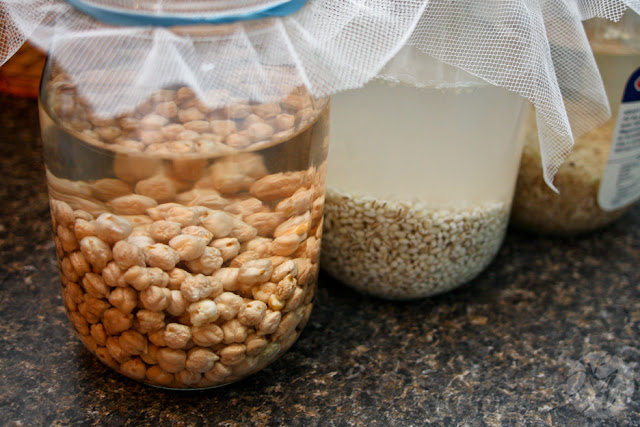This post in the "newness" theme is the first of a two-parter that will give me the chance to share with you something new I've learned recently and am trying.
I took a cooking class last week from a group in Indy called Fermenti Artisan. I found them through the local blogosphere, stumbled upon their Facebook page, and signed up for the first class in their "Sprouting & Soaking 1 - Whole Seeds, Grains, Nuts & Legumes" series. I went with one of my girlfriends, and we ended up really being the only two people in the class. It was a little odd but gave us lots of time to ask questions (and take leftovers at the end of the night!).
The class focused on the benefits of and ways to go about soaking and/or sprouting your whole grains, beans, legumes, nuts, and seeds. By planning ahead a little, it's a way to 1) take the nutritional value of these foods to the next level and 2) make these foods more easily digestible. Sounds good to me!
We started with an informational 30 minutes (here's a link to the Wikipedia page on the subject, if you're curious), then dove into the kitchen and started cooking. Through the next 90 minutes, we watched the chef (and helped a little) make a series of five or six different recipes that used sprouted whole foods. We made everything from walnut milk and walnut butter, to oatmeal, sprouted salad, porridge, wheat-butter crackers, and fruit/nut snack bars.
Maybe it's partially the fact that I'm excited for spring to get here so I can put in my new garden, but I'm kind of fascinated by this. (It's a bit like gardening on my counter top.) Part of what's so great is this can be really inexpensive -- the supplies aren't expensive (and you can even get by with what you probably already have), and by buying dry beans or grains in bulk, it's an easy way to save money. I immediately borrowed some spare wide-mouthed glass jars from Mom's canning stash, filched some tulle fabric off her for straining screens, and got to work!
Pictured above are dry garbanzo beans starting to soak, pearled barley, and brown rice. I soaked all three for 24 hours. The beans expanded to about double their volume, then they started sprouting after about another 24-48 hours. The barley won't sprout, and I didn't take the rice to that point, but by having soaked them first, I cut down on their cooking time by about half. I made a salad out of the barley and rice, and I'm going to cook the beans and just use them in meals here and there over the next week.
This has opened my eyes to an entirely new world of cooking. If you're curious to give it a try yourself, the website I keep seeing recommended and trusted is sproutpeople.org. They have starter kits, seeds to start, recipes, articles, instructions, you name it.
Have you ever tried this?
My next post will show you some of the results of my sprouting experiments!
Camera: Canon 40D with 24mm wide-angle lens and 430EX Speedlite, 1/125s, f/2.8 at ISO 640


I am soooooooooooooooo jealous of this class you're in!! This sounds awesome. I've tried buying the dry beans and soaking them (I say this cuz it looks like you're soaking chickpeas) and have absolutely NO luck and am condemned to the canned stuff. Good luck! Oh yeah, and nice pic too ;)
ReplyDeleteYes, the jar on the left does contain dry chickpeas. I'm surprised you've had no luck! Try doing some googling on the subject, because I've found several good tutorials -- perhaps you can figure out what may be foiling you? The chickpeas sprouted after a day of soaking and another 48 hours of rinsing and resting, so it did take longer. Don't give up hope yet! :) Let me know if you end up having success!
ReplyDelete